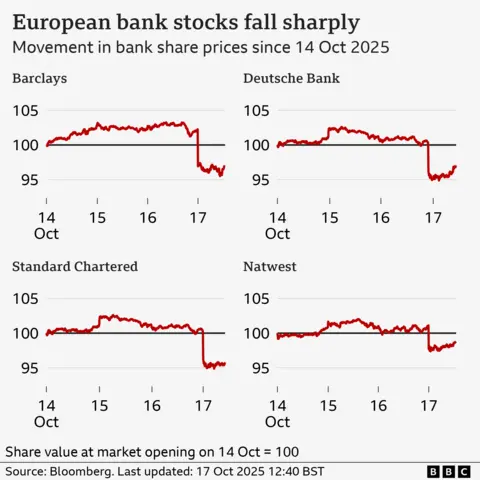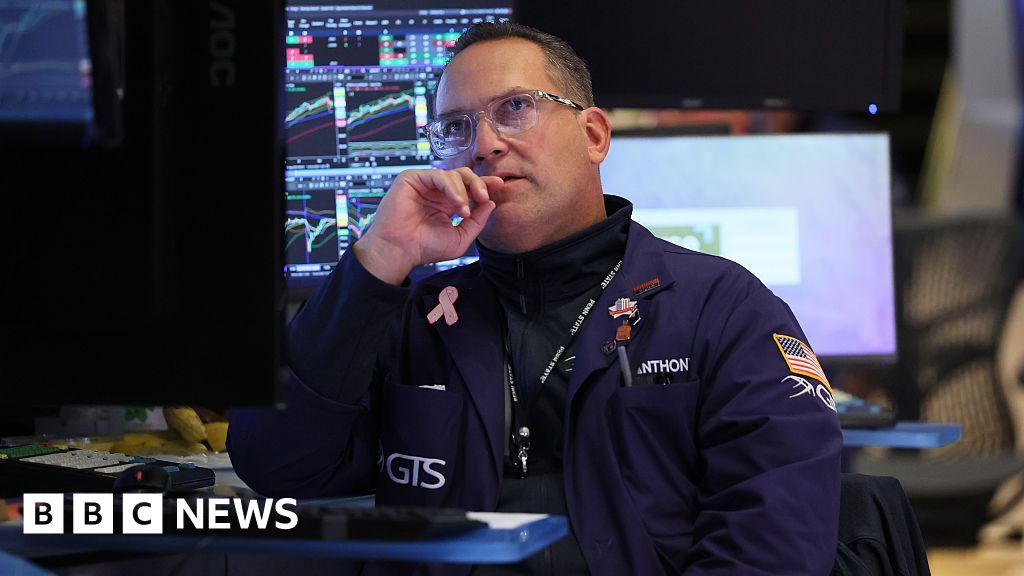Ben KingBusiness reporter
 Getty Images
Getty ImagesShares are recovering after a warning of fraud from two US banks triggered a sell-off around the world.
Two US regional lenders, Western Alliance Bank and Zions Bank, said on Thursday that they had been hit by either bad or fraudulent loans, sparking fears of problems in the banking sector.
Some of the UK’s biggest banks, including Barclays and Standard Chartered, saw their share prices fall more than 5% on Friday morning, before recovering.
The FTSE 100 index of leading shares had dropped about 1.5% at one point before regaining some ground.
The US S&P 500 benchmark was marginally up in early trading after Donald Trump appeared to indicate that high tariffs (export taxes) on China may not be “sustainable”.
On Thursday, Zions Bank said it would write off a $50m loss on two loans, while Western Alliance disclosed it had started a lawsuit alleging fraud.
“Pockets of the US banking sector including regional banks have given the market cause for concern,” said Russ Mould, investment director at AJ Bell.
“Investors have started to question why there have been a plethora of issues in a short space of time and whether this points to poor risk management and loose lending standards.”
“Investors have been spooked,” he added, saying that while there was no evidence of any issues with UK-listed banks, “investors often have a knee-jerk reaction when problems appear anywhere in the sector”.
Bank shares in Europe were also hit, with Germany’s Deutsche Bank down more than 5% and France’s Societe Generale dropping 4%, before recovering some ground.
Asian markets fell earlier on Friday. Japan’s Nikkei index closed down 1.4% and in Hong Kong the Hang Seng Index ended the day 2.5% lower.
But shares of some of the US banks hit hardest on Thursday appeared poised to claw back some ground.
In early morning trade on Friday, shares in Zions Bank were up about 5%, following its 13% fall on Thursday. Shares in Western Alliance Bancorp, which had dropped almost 11%, were also up roughly 3%.

In an interview on the Fox Business Network, the director of the White House National Economic Council described the issues as “messes” left by the Biden administration, while maintaining that US banks were well positioned to handle the stress.
“Right now, the banking sector has ample reserves,” Kevin Hassett said. “We’re very optimistic that we can stay way, way, way ahead of the curve on this.”
Investors have been nervous following the failure of two high-profile US firms, car loan company Tricolor and car parts maker First Brands.
These failures have raised questions about the quality of deals in what is known as the private credit market – where companies arrange loans from non-bank lenders.
This week Jamie Dimon, the boss of the US’s largest bank JPMorgan Chase, warned that these two failures could be a sign of more to come.
“My antenna goes up when things like that happen,” he told analysts. “I probably shouldn’t say this, but when you see one cockroach, there are probably more. Everyone should be forewarned on this one.”
There have also been warnings that the surge in artificial intelligence investment has produced a bubble in the US stock market – including from Mr Dimon – leading to fears that shares are overvalued.
The market turbulence on Friday saw the price of gold reach a fresh record high of $4,380 per ounce, as investors looked for safe havens for their money.
Another closely watched measure of market nerves, the VIX volatility index sometimes called the “Fear Index”, hit its highest level since April.
Source link



